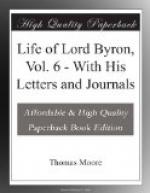He was sitting, at about eight o’clock, with
only Mr. Parry and Mr. Hesketh, in the apartment of
Colonel Stanhope,—talking jestingly upon
one of his favourite topics, the differences between
himself and this latter gentleman, and saying that
“he believed, after all, the author’s
brigade would be ready before the soldier’s printing-press.”
There was an unusual flush in his face, and from the
rapid changes of his countenance it was manifest that
he was suffering under some nervous agitation.
He then complained of being thirsty, and, calling
for some cider, drank of it; upon which, a still greater
change being observable over his features, he rose
from his seat, but was unable to walk, and, after
staggering forward a step or two, fell into Mr. Parry’s
arms. In another minute, his teeth were closed,
his speech and senses gone, and he was in strong convulsions.
So violent, indeed, were his struggles, that it required
all the strength both of Mr. Parry and his servant
Tita to hold him during the fit. His face, too,
was much distorted; and, as he told Count Gamba afterwards,
“so intense were his sufferings during the convulsion,
that, had it lasted but a minute longer, he believed
he must have died.” The fit was, however,
as short as it was violent; in a few minutes his speech
and senses returned; his features, though still pale
and haggard, resumed their natural shape, and no effect
remained from the attack but excessive weakness.
“As soon as he could speak,” says Count
Gamba, “he showed himself perfectly free from
all alarm; but he very coolly asked whether his attack
was likely to prove fatal. ’Let me know,’
he said; ‘do not think I am afraid to die—I
am not.’”
This painful event had not occurred more than half
an hour, when a report was brought that the Suliotes
were up in arms, and about to attack the seraglio,
for the purpose of seizing the magazines. Instantly
Lord Byron’s friends ran to the arsenal; the
artillery-men were ordered under arms; the sentinels
doubled, and the cannon loaded and pointed on the
approaches to the gates. Though the alarm proved
to be false, the very likelihood of such an attack
shows sufficiently how precarious was the state of
Missolonghi at this moment, and in what a scene of
peril, confusion, and uncomfort, the now nearly numbered
days of England’s poet were to close.
On the following morning he was found to be better,
but still pale and weak, and complained much of a
sensation of weight in his head. The doctors,
therefore, thought it right to apply leeches to his
temples; but found it difficult, on their removal,
to stop the blood, which continued to flow so copiously,
that from exhaustion he fainted. It must have
been on this day that the scene thus described by
Colonel Stanhope occurred:—
“Soon after his dreadful paroxysm, when, faint
with over-bleeding, he was lying on his sick bed,
with his whole nervous system completely shaken, the
mutinous Suliotes, covered with dirt and splendid
attires, broke into his apartment, brandishing their
costly arms, and loudly demanding their wild rights.
Lord Byron, electrified by this unexpected act, seemed
to recover from his sickness; and the more the Suliotes
raged, the more his calm courage triumphed. The
scene was truly sublime.”




